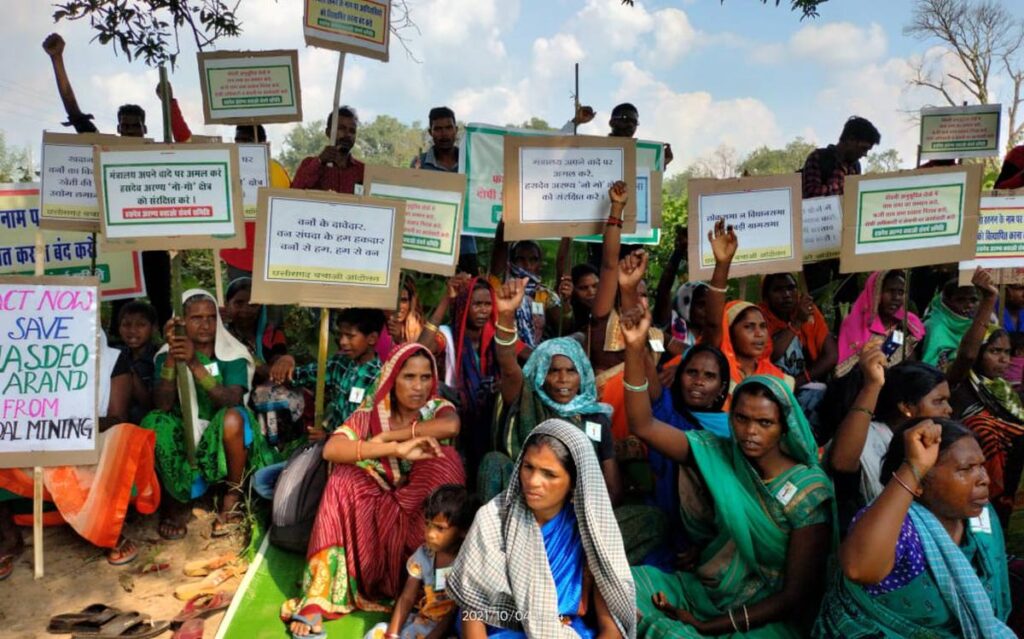For years, tribal and forest-dwelling communities have opposed mining in Chhattisgarh’s Hasdeo Arand, one of central India’s most dense forests. The latest chapter in the saga of resistance is how they forced the stoppage of the Parsa open cast mining (OCM) project barely two months after the Chhattisgarh government approved it in April.
Parsa’s mining history is riddled with allegations of forgery, court cases, legal violations, and political power play. The Hasdeo Arand Coalfields (HACF) spread over 1,876 square kilometres hold an estimated 2,032 million tonnes of proven coal reserves, according to the Ministry of Coal. The Parsa coal block is one of 23 blocks in the HACF, which spans Surguja and Surajpur districts in north Chhattisgarh.
Until now, only the Adani Group’s Parsa East and Kanta Basan (PEKB) coal blocks here have received approval for mining and they have been in operation since April 2013. However, the adjacent Parsa block, which was first allocated in August 2006, has faced stiff resistance when it sought to begin operations after obtaining clearance.
On April 6, the Chhattisgarh government approved the clearing of the forest for the Parsa OCM project, which threatens to destroy 800 hectares of forest, besides land, livelihood, and culture in six villages. The residents of these villages rose in protest.
Two months later, on June 9, the State government put three mining projects in Hasdeo Arand, including the Parsa OCM project, on indefinite hold. The final push apparently came after T.S. Singh Deo, the State Health Minister and Ambikapur MLA, publicly supported the protests after he met the villagers of Ghatbarra, Salhi, and Hariharpur in his constituency a few days earlier. He opened up after Chief Minister Bhupesh Baghel stood by his decision to allow mining to continue and remarked that protesters should turn off the lights in their homes.
‘No-go’ category
Miners have eyed the coal beneath the green cover for over a decade now. Hasdeo’s 23 coal blocks fall under a “No-Go” category listed in a joint study published by the Union Ministry of Environment, Forest and Climate Change and the Ministry of Coal in December 2011. The study classified unfragmented forest landscapes with a gross forest cover of over 30 per cent as “No-Go” areas for mining. In other words, after a survey of 602 coal blocks in nine major coal fields across India, the study classified 153 as “No-Go”. Interestingly, in the same month Rajasthan Colleries Ltd (RCL) was formed as a joint venture between Rajasthan Rajya Vidyut Utpadan Nigam (RVUNL, Rajasthan’s electricity generation company) and Adani Enterprises Limited (AEL, Adani Group’s flagship company). Four years later, RVNUL engaged RCL as the Mine Developer and Operation (MDO) contractor for the Parsa project.
Earlier, in June 2011, the Union Environment Ministry’s Forest Advisory Committee (FAC) had rejected proposals to open up the Tara and PEKB blocks for mining. But Jairam Ramesh, the then Environment Minister in the United Progressive Alliance government, overruled the FAC’s recommendations and granted Stage-I clearance for the blocks. On three earlier occasions in 2010, he had apparently agreed with the FAC’s rejections.
On September 24, 2014, the Supreme Court cancelled more than 200 coal block allocations made between 1993 and 2011, terming them illegal and arbitrary. This gave the Bharatiya Janata Party (BJP), which had come to power in the State earlier that year, a clean slate to begin with.
In March 2015, the Central government, led by the BJP, enacted the Coal Mines (Special Provisions) Act, 2015, which allowed the immediate allocation of coal mines to successful bidders and allottees. This paved the way for the government to once again, in September, allot the Parsa coal block to RVUNL, which in turn engaged RCL for mining.
Every party in power, be it at the Centre or in the States, has played a similar role. For instance, in 2015 Rahul Gandhi and Baghel stood by the villagers protesting against mining in the HACF. But after the Congress came to power in Chhattisgarh in December 2018, it took the party’s government nearly four years to stop the mining projects in Hasdeo. The BJP in Chhattisgarh has demanded Singh Deo’s resignation for failing the people.
Legal violations
Outright violations and the use of legal loopholes have marred the process of obtaining mining clearances. In January 2015, 20 gram sabhas passed a resolution stating that the auction of coal mines was in violation of the Forest Rights Act (FRA), 2006. Faced with protests, in February 2016 the State government “illegally” cancelled the forest rights vested in the tribal people of Ghatbarra village by the FRA on the grounds that they hindered mining activities. This was the first such order to be passed despite the fact that the rights conferred are “inalienable”, that is, they cannot be revoked.
In April 2018 , RVUNL informed the Union Environment Ministry of two public hearings held in Surguja and Surajpur in October and November 2017 to obtain environmental clearance as required by the Environment Impact Assessment notification, 2006.
Hasdeo Arand is an area listed in the Fifth Schedule of the Constitution (dealing with the administration and control of Scheduled Areas as well as of Scheduled Tribes residing in any State other than the States of Assam, Meghalaya, Tripura and Mizoram). Provision 4(k) of the Panchayats (Extension to the Scheduled Areas) Act, or PESA, says that “the recommendations of gram sabha shall be made mandatory prior to the grant of prospecting licence or mining lease in the Scheduled Areas”. Section 4(i) of the Act says that “gram sabhas shall be consulted before making the acquisition of land” in these areas.
“The land acquisition took place under the Coal Bearing Areas (Acquisition and Development) Act, 1957, [CBA], and the user agency [project proponent] bypassed the gram sabhas’ approval which is mandated by PESA. The sabhas’ approval is not mandated under the CBA,” said Bipasha Paul, lawyer and member of the Hasdeo Aranya Bachao Sangharsh Samiti.
Bypassing laws
In a May 2018 letter addressed to the Environment Ministry, RVUNL cited Naresh Singh & Ors to argue that the provisions of PESA would not apply to an acquisition of land under the CBA. In an April 2018 letter to Chhattisgarh’s Tribal Welfare Department, RVUNL had said that villagers “supported the project and were convinced (it) will bring improvement to the local infrastructure”. They also attached copies of no-objection certificates (NOCs) reportedly issued by all the gram panchayats concerned (as required by the FRA and the Forest (Conservation) Act, 1980). Activists and members of Hasdeo Aranya Bachao Sangharsh Samiti, however, alleged that the NOCs were forged.
“The influential gram sabhas of Hariharpur, Salhi, and Fatehpur [also in Surguja] did not give their consent, and yet clearances were awarded, which people have been protesting against,” said Alok Shukla, convener of the Chhattisgarh Bachao Andolan, a collective that fights for community rights and self-governance. “The documents were forged, the entire process was bypassed by the proponents of the project,” he told Frontline. Despite his allegations, the documents are yet to be investigated.
T.S. Singh Deo made similar allegations about “false gram sabhas” in which the villagers had not participated. “Their names were taken and signatures were forged. Among the names mentioned, five were already dead. More than 40 people have given written affidavits saying they never attended the meeting,” Singh Deo claimed.
This writer sought a response from the Adani Group on the allegations of wrongdoings, dilution of environmental safeguards, and infringement of the FRA. No reply was received until the time of this article going to press.
In December 2021, land acquisition for Parsa under the CBA was challenged in the High Court, and in May this year the court quashed it for lack of merit. The project got environmental clearance in July 2019 and Stage-I forest clearance in February 2020. The stipulated conditions included bearing the cost of compensatory afforestation and getting consent from gram sabhas. Stage-II clearance was given in October 2021.
Ecological impact
The project’s proponents have been accused of violating wildlife laws as well. The ecologically sensitive Hasdeo forests are located between the Achanakmar Tiger Reserve in Chhattisgarh and the Palamu Tiger Reserve in Jharkhand.
“They did not seek permission from the National Tiger Conservation Authority,” said Shukla, who wrote to the NTCA in April 2022, prompting it to seek an explanation from the Chhattisgarh Chief Wildlife Warden on bypassing the mandatory approvals for felling trees. The Wild Life (Protection) Act, 1972, entrusts the NTCA with the task of evaluating and disallowing any land use that it deems “ecologically unsustainable”, such as mining and industrial projects.
The environmental clearance for mining the Parsa coal block was granted on the condition that RVUNL would fund a comprehensive biodiversity and wildlife study by the Indian Council of Forestry Research and Education and the Wildlife Institute of India; this was published in July 2021. If central India’s largest contiguous forests are fragmented, the study noted, it will decrease the connectivity of migratory corridors of elephants and tigers.
“The grant of approvals despite unresolved procedural lapses, allegations of fabricated documents, and shortfalls in impact assessments set an undesirable precedent that can justify the opening of several other coal blocks in Hasdeo Arand forests,” said Kanchi Kohli, senior researcher at the Centre for Policy Research. Activists also claim over two lakh trees will be cut for the Parsa project, despite the forest clearance stating that 95,485 trees will be axed.
Plight of tribal people
“The plight of tribal people like us will be like that of a fish taken out of water,” said Ramlal Kariyam, a resident of Salhi. According to him, the project will displace four villages, Hariharpur, Fatehpur, and parts of Salhi, and Tara. He described how the Adivasi communities are entirely dependent on the forest, with most of their income coming from the sale of mahua and tendu leaves they collect.
“Our culture is also tied to the forests where we worship our deities. Every season the village gathers to pray under the sal trees, which would now be cut down,” he said.
According to Bipasha Paul, more than 4,000 people will be affected by the project. Singh Deo said that communities would be left with no recurring source of livelihood should they lose their forests and land.
“There is also the classic environment justice problem of people who are going to face the impact of coal extraction not going to benefit from it,” Kohli said.
According to Land Conflict Watch database, Chhattisgarh has seven conflicts listed under coal mining. This has affected 32,815 people and 16,142 hectares of land and involves Rs.31,294 crore in investments.
India’s coal demand
Many activists question the allocation of new mines. Citing Coal India Ltd and the Central Electricity Authority, an article by the Centre for Research on Energy and Clean Air pegged India’s coal demand to be 1,300–1,900 million tonnes per annum (MTPA) by 2030. As of 2017, the total capacity of the country’s allocated mines was about 1,500 MTPA. “The minable capacity of already allocated blocks is around 15-20 per cent higher than the expected demand in 2030. This raises a question on the further need to allocate or auction new coal blocks,” the report noted.
In a written reply in the Lok Sabha in March 2022, the Ministry of Coal stated that India’s transition from coal is not possible in the foreseeable future. Citing the draft Economic Survey 2021-22, it mentioned that India’s demand is likely to increase by 63 per cent from the current demand.
“This means there will still be areas like Parsa where coal extraction will continue,” said Kohli.
(Pragathi Ravi is an intern at Land Conflict Watch, an independent network of researchers studying land conflicts, climate change and natural resource governance in India. Courtesy: Frontline magazine.)




